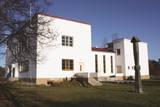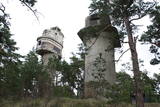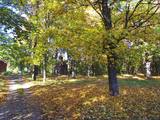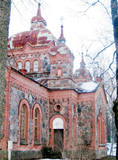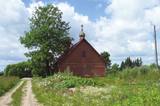| Nr | Name | Beschreibung |
|---|---|---|
|
Befindet sich in einem 1911 errichteten Gebäude der Molkerei. Herstellung von Milch, Kefir, Buttermilch, saure Sahne, Sahne, Quark, süße Quarkcreme, Butter, Joghurt und Käse. Die Produktion kann man in einem Geschäft der Molkerei (in der Nähe vom Unternehmen) kaufen. Im Geschäft kann man auch die von den Kooperationspartnern (A/s „Smiltenes piens” und SIA „Latvijas piens”) hergestellten Käsespezialitäten kaufen. Eines der fünf lettischen Unternehmen, das den weichen Kümmelkäse "Jāņu" herstellen darf, der als garantiert traditionelle Spezialiät in das EU-Register eingetragen ist. Die Erzeugnisse des Unternehmens haben die Qualitätszeichen „Grüner Löffel” und „Latvijas labums” erhalten. Für die Gruppen – Verkostungen und Einblick in die Tätigkeit der Milchgenossenschaft. |
||
|
The large farm is to the South of the centre of Lone, producing apples, pears, plums, cherries, strawberries and black currants. It stores apples during the whole winter. You can help to pick the fruit and berries and purchase them for yourself. |
||
|
Das livische Volkshaus – das 1939 gebaute Haus ist ein Symbol der livischen Identität.
Im Volkshaus kann man eine für die Liven gewidmete Fotoausstellung betrachten.
|
||
|
Der Hof und der dendrologische Garten befindet sich unweit von Kuldiga. Im Teich am Haus werden Karpfen und Forellen gezüchtet. Neben dem Gästehaus befindet sich die 1960 angelegte Baumschule „Sauleskalni“. Derzeit finden Sie hier etwa 100 Arten Bäume und Sträucher, darunter 25 heimische Arten und 16 Arten und Sorten Rhododendron. Besondere Stücke sind die älteste Magnolie Lettlands (50 Jahre), ein 45 Jahre alter Perückenstrauch (Cotinus coggygria), ein Ginkgo (Ginkgo biloba), Eleutherococcus sessiliflorus und andere. Als Eintritt ist eine Spende erwünscht. Es gibt einen Raum, der den Gründern des Gartens und deren Geschichte gewidmet ist. Man kann diverse Pflanzen kaufen. |
||
|
Meklējama Gosporos, starp Rīgas – Daugavpils šoseju (A 6) un Daugavu. Apjomā nelielais dievnams būvēts 1820. gadā romāņu stilā no laukakmeņiem senas kapsētas vietā. Tuvāk Daugavai ir izveidota aka, no kuras iztek Svētavots, kam piedēvē dziednieciskas īpašības. Pie baznīcas novietots dobumakmens. |
||
|
The craftspeople offer tours during which you can watch them at work. You can also produce your own souvenirs with various techniques, including the potter’s wheel and the engraving technique, making use of pre-prepared moulds. You can also commission and purchase ceramics products. This location is popular among children and wedding parties. |
||
|
This programme allows participants to learn about Latvian ethnography and traditions through meeting local craftsmen and having master classes with them in knitting traditional mittens and gloves, making amber jewellery and cooking traditional foods. There is chance to have a unique experience because of the authenticity of some places and traditions, for example the ethnographic house of living history Zvanītāji still retains its original appearance - massive ceilings, large family room with bread oven and natural, unpainted wooden floor. The carew chimney is still in the kitchen. The house is filled with characteristic looms, a family table, beds, wardrobe, cradle, various items and tools used on the farm. |
||
|
Am leichtesten kann man diese Batterie finden, wenn man entlang der Meeresküste geht, weil eine von den vier Positionen der Batterie am Strand liegt (abgespült von Meereswellen). Die übrige Positionen, Entfernungsmesser, als auch andere Elementen sind in der Nähe von der Meeresküste – im Kieferwald gelegen. Die Batterie wurde in den vierziger Jahren des vorigen Jahrhunderts aufgestellt. Von diesem Ort kann man die nördischen Befestigungswerke sehen.
|
||
|
Puša Manor - Chapel was built in the end of the 18th century; it is located
in the Pušas Manor park that was built in the middle of the 19th
century. Both are permanent local architectural monuments.
|
||
|
Pie dažus metrus augstajām klintīm pavasaros un pēc
lietavām veidojas divi nelieli sezonāli ūdenskritumi.
|
||
|
Das Unternehmen stellt Milch, Quark und Quarkprodukte, Joghurt, Desserts her. Für die Herstellung der Erzeugnisse wird Milch von hoher Qualität verwendet. Die Milch wird von mehr als 100 bäuerlichen Betrieben und 3 Kooperativen geliefert. Alle Produktionsprozesse werden eingehalten und verbessert für die Verbesserung des Geschmacks und Erhöhung des Nährwertes der Produktion. Betriebsbesichtigung und Verkostung. Eines der fünf lettischen Unternehmen, das den weichen Kümmelkäse "Jāņu" herstellen darf, der als garantiert traditionelle Spezialiät in das EU-Register eingetragen ist. Die Erzeugnisse haben das Qualitätszeichen „Grüner Löffel” erhalten. |
||
|
Bis 1724 gehörte das Gut damals als Vorwerk Cecina der Familie Hylzen. Nachdem die Tochter Jadvyga Jan Szadurski geheiratet hatte erscheint das Gut 1774 in Dokumenten unter dem Namen Malnava. Weiterhin gab es noch mehrere Besitzerwechsel. Das Hauptgebäude des Gutes ist im Stil des Klassizismus errichtet, teilweise mit barocken Zügen. Auf einer Seite des Gutshofes befindet sich ein Speicher, das Herrenhaus befindet sich an der Stirnseite des Hofes. Zum Zeitpunkt der Bodenreform in Lettland 1920 war das Gut Malnava mit 12.400 Heltar eines der größten Güter in Lettland. Das Gutshaus wurde im 2. Weltkrieg zerstört, zwar wurde es wiederaufgebaut, aber die Inneneinrichtung ist nicht erhalten. Von den Wirtschaftsgebäuden ist der aus der ersten Hälfte des 19. Jh. stammende klassizistische Speicher erhalten sowie einige weitere Gebäude. Das Gutsensemble wird von einem Park ergänzt, in dem jetzt immer noch einige fremdländische Bäume und Sträucher wachsen, z.B. ein Amur-Korkbaum. Es gibt auch zwei Stahlbetonbunker, wo Hitler Mal kurze Zeit anwesend war. Auf dem Territorium befindet sich auch die Schnapsbrennerei der Marke „Latgales šmakovka“, wo Besucher sich mit der Herstellung von Hochprozentigem von frühesten Zeiten bis heute bekannt machen können. |
||
|
The rock is not too big (2.1 m high, 15 m in circumference), but since the early 20th century it has been a popular tourist destination. There is a lovely view of the
|
||
|
Atrodas Rucavas – Bārtas ceļa malā (pagrieziens uz Bārtas Romas katoļu baznīcu). Veltīts melioratoram Arvīdam Manfeldam – bijušā Liepājas rajona meliorācijas uzņēmuma priekšniekam kā pateicība no vietējiem iedzīvotājiem par ceļiem un tiltiem. |
||
|
Nītaures vēstures takā var apskatīt un iepazīt dažādus vēsturiskus objektus no 13.gadsimta līdz mūsdienām - seno pilskalnu, vācu ordeņa pilsdrupas, luterāņu un pareizticīgo baznīcas, soda vietu un muižas seno apbūvi. |
||
|
Das Café befindet sich im Zentrum von Gaigalava, in dem ehemaligen Verwaltungsgebäude der Kolchose. Für die Vorbereitung der Speisen werden Produkte aus dem eigenen Hof und aus anderen Höfen verwendet. Lettische Küche: Bohnensuppe mit Graupen, Sauerkrautsuppe, Erbsensuppe, Suppe aus den Blättern der roten Beete, Ampfersuppe, Fischsuppe aus Schleien oder Karpfen, gebratene Rippen, Braten, falscher Hase, im Ofen gebackener Karpfen, getrocknete Fische, Quarkcreme mit Kompott, gebackene Äpfel mit Vanillesoße, geflochtene Rouladen, getrocknete Früchte und kandierte Quitten. Das besondere Gericht: Bohnenpfannkuchen. |
||
|
It is worth hiking this road where in crosses the Šlītere Blue Hills. This part of the road is approximately one kilometre long, and it goes down to the valley of the stream which crosses the hills. The place has been given a peculiar name – the Kušperlankgrāvis ravine (or the Zeltiņi ravine, as is claimed in other sources). If you're driving, be careful, because there is no bridge here, just a ford. During the early spring or the winter, you will appreciate the ravines and the impressive Blue Hills themselves. Impressive sandstone cliffs which are several metres high and have been vandalised by human hands are on both sides of the road. There is a small niche in one of the cliffs. To the right (East) from the road at the terrace of the Blue Hills is a side road which leads to the Mežlīdumi homestead. Please be gentle with the cliffs! |
||
|
“Rūme” - vieta Sēlijā, Zasā, kur tiekas radoši amatnieki un īsti Sēlijas zinātāji, kas lepojas ar savu sēļu mēli un sēļu tērpiem. Tieši šajā amatniecības centrā bieži vien amatnieki atrāda savus darba augļus, un cilvēki pulcējas uz dažādiem pasākumiem. |
||
|
Rimši Old-Believers Prayer House. The church was built in the
beginning of the 20th century.
|
||
|
The farm breeds cattle and grows vegetables. You can receive consultations and purchase seeds and vegetables. |
||


